This Best Prime Rib Recipe is a meltingly tender show stopper with a pepper, garlic-herb studded crust dripping with so much flavor you will be obsessed.
Readers repeatedly rave: “This is the best prime rib we’ve ever had!” “OUTSTANDING!!” and “Perfectly juicy and sooo tasty. Everyone loved it!” This no-fail recipe with step-by-step photos, tips, and tricks will have you joining readers in exclaiming, “I was so intimidated…Your recipe was very easy to follow and turned out absolutely perfect!!!”
Watch How to cook Prime Rib
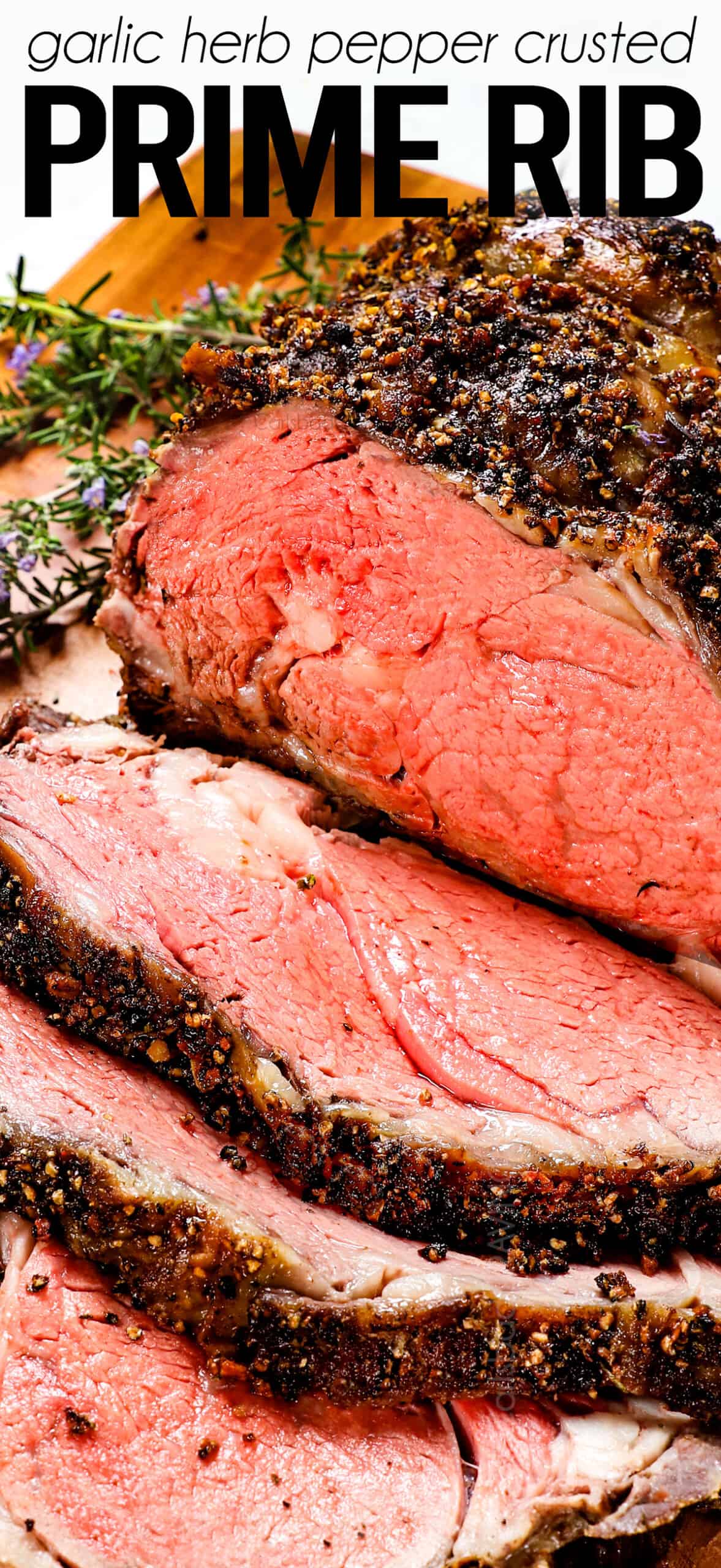

This is the Best Prime Rib Recipe
I’ve experimented and perfected this recipe to create the ultimate guide to achieve the best prime rib– even if you’ve never cooked one before! Here’s why it’s the best:
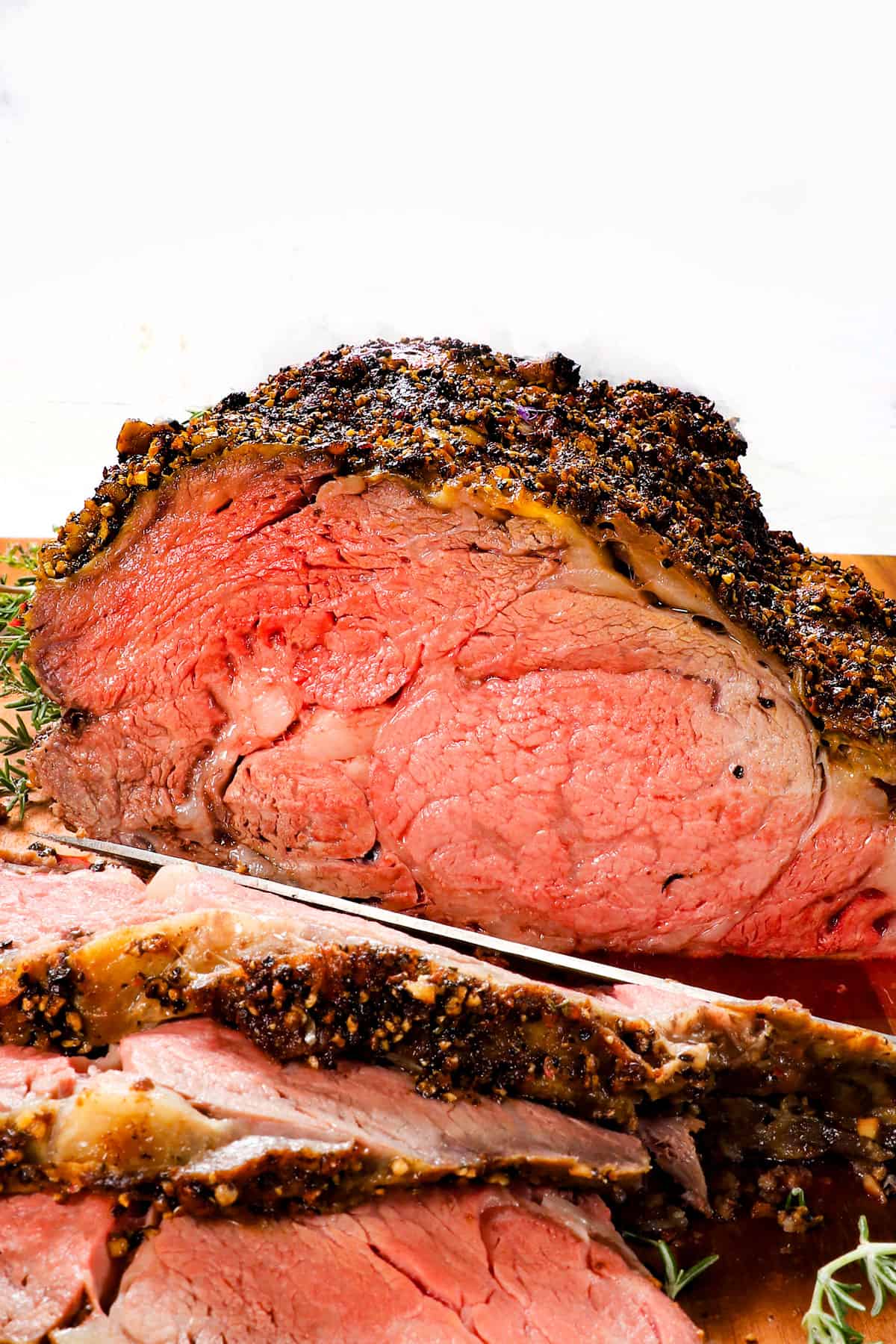

Prime Rib Recipe ingredients
This prime rib recipe is made with relatively few ingredients, so it’s important to pick the best! Let’s take a closer look at what you’ll need (full measurements in the printable recipe card at the bottom of the post):
Purchasing prime rib:
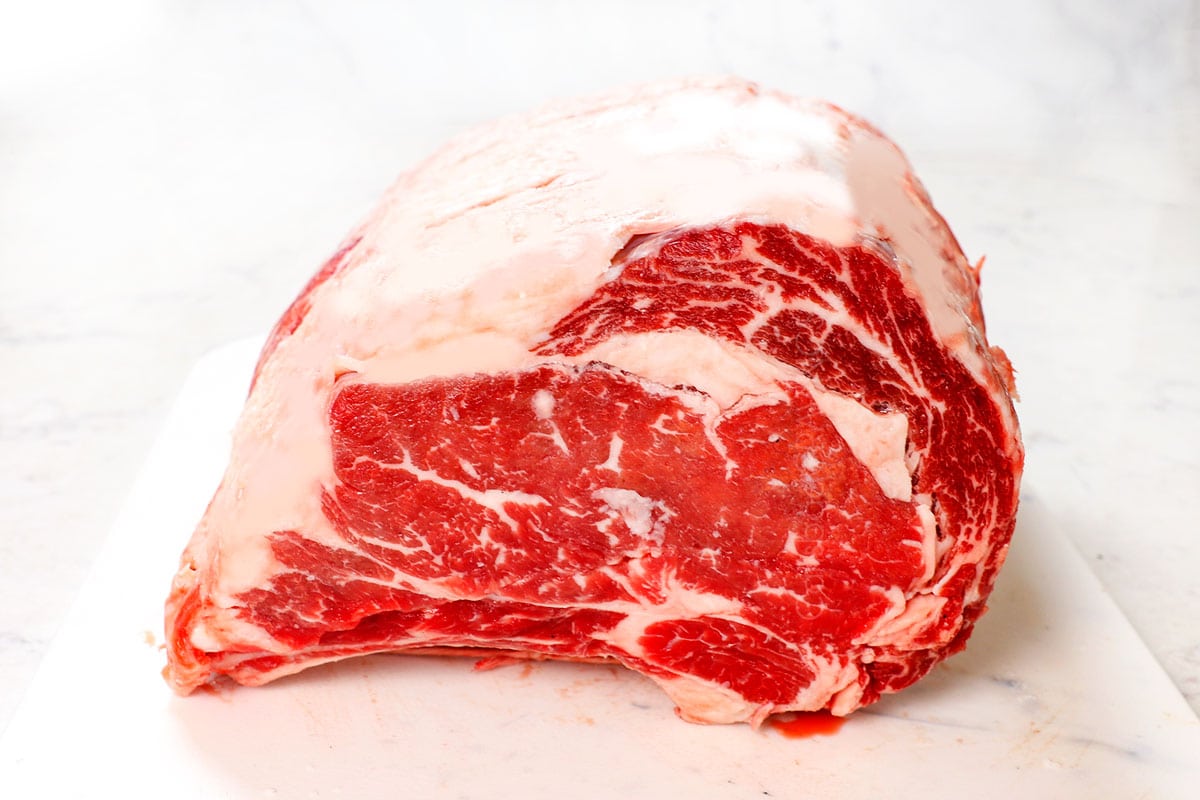
Prime Rib Seasoning

meat thermometer for COOKING THE best prime rib
You need a probe meat thermometer that stays in the meat while it cooks in order to cook the perfect prime rib, otherwise, you are opening and closing the door to check the temperature which disrupts even cooking. Also, it’s difficult cook the prime rib perfectly.
I recommend this digital probe thermometer as seen in the photos and video. It is my favorite – I give it out as gifts – you will never overcook any beef, chicken, pork or fish again. Best of all, it’s only $25 on Amazon! The thermometer allows you to set the desired temperature and an alarm will set as soon as it reaches the set temperature.
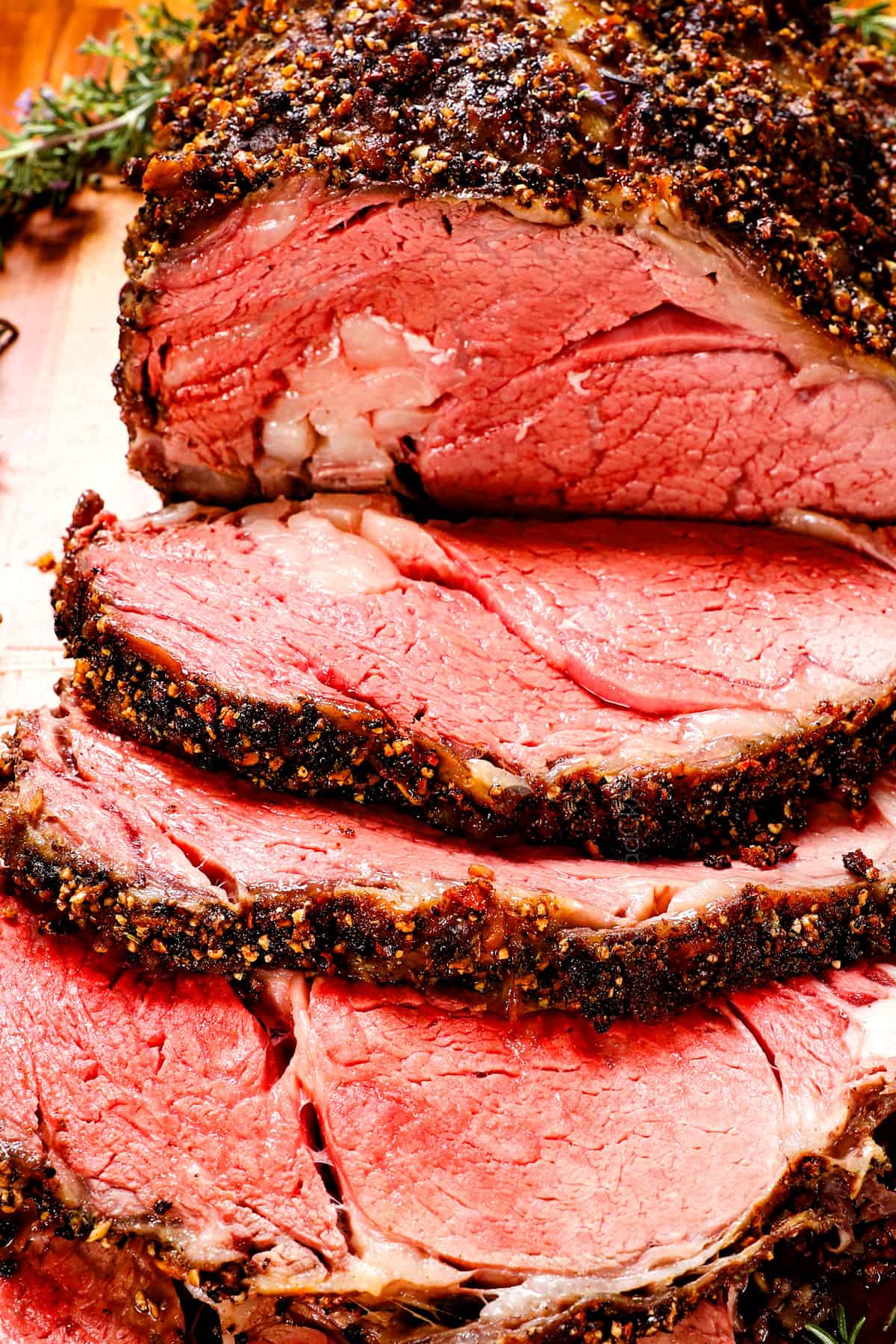

dry brining prime rib Roast
Dry brining promotes a spectacular seared crust and achieves deeply seasoned, juicy, tender beef. It may sound fancy, but it simply means seasoning the beef with salt and chilling. If you don’t have time, you can just salt and let it rest while it comes to room temperature – so don’t stress about this process!
HOW IT WORKS:
1. Deep seasoning: The moisture of the meat breaks down the salt creating a glaze which you will be able to see sitting on the surface of the beef. The glaze eventually seeps back into the meat as the salt moves from an area of high concentration (the surface of the beef) to a lower concentration (inside the beef), deeply seasoning the meat.
2. Tenderizes: The salt breaks down the cell proteins so they can no longer contract when cooking which allows the cells to hold onto more water resulting in juicier beef.
3. Golden crust: The salt helps achieve better surface browning – the hallmark of any perfect prime rib. The salts result in a quicker Maillard reaction and crispier crust because the surface of the meat stays drier during searing and cooking.

How to cook Prime Rib Roast
Cooking the best prime rib is easier than you think. There are a few steps, but each is easy! As mentioned, the key is to use a digital probe thermometer to cook it perfectly every time. Let’s take a closer look with step-by-step photos (full recipe in the recipe card at the bottom of the post):
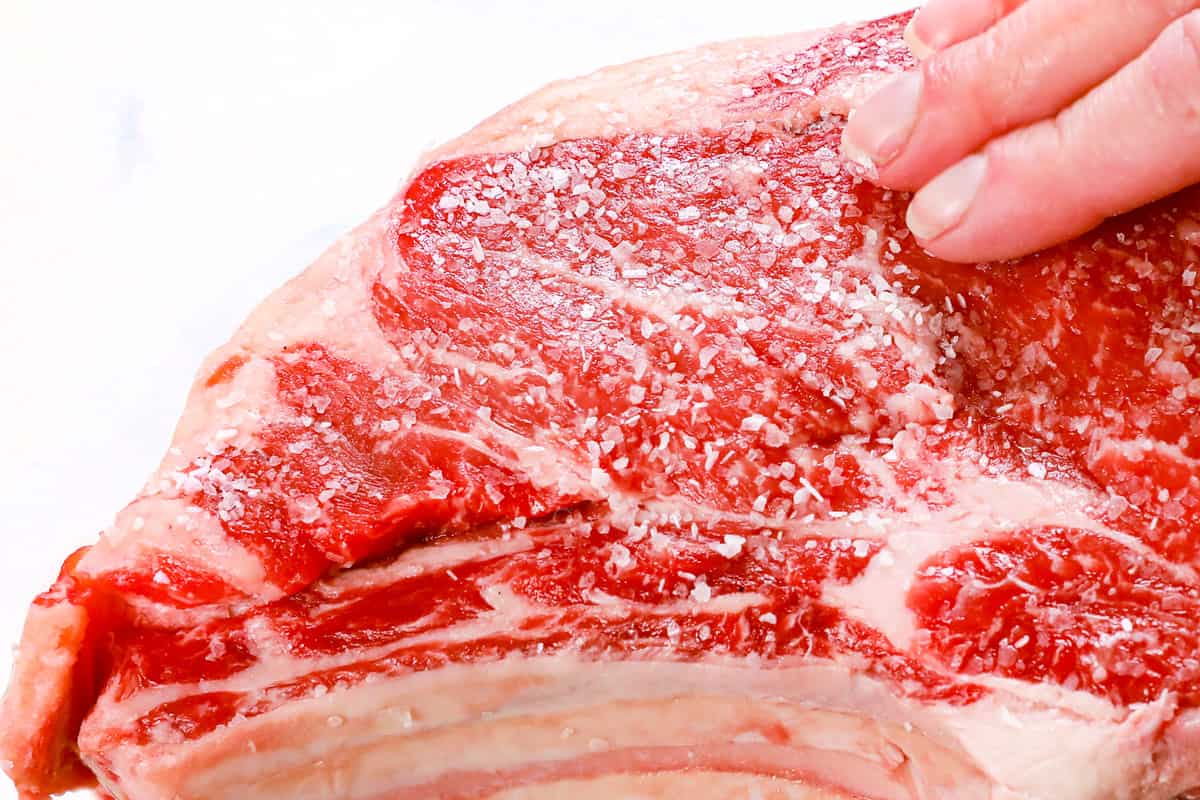
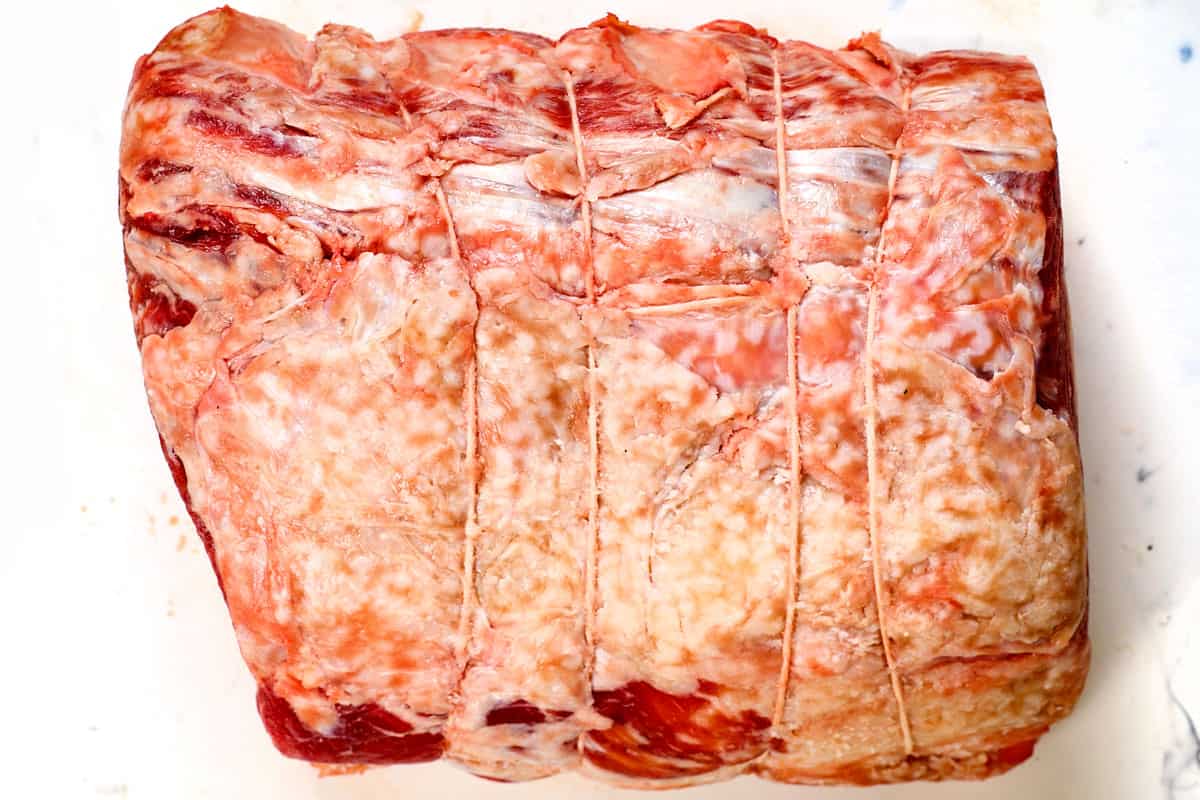

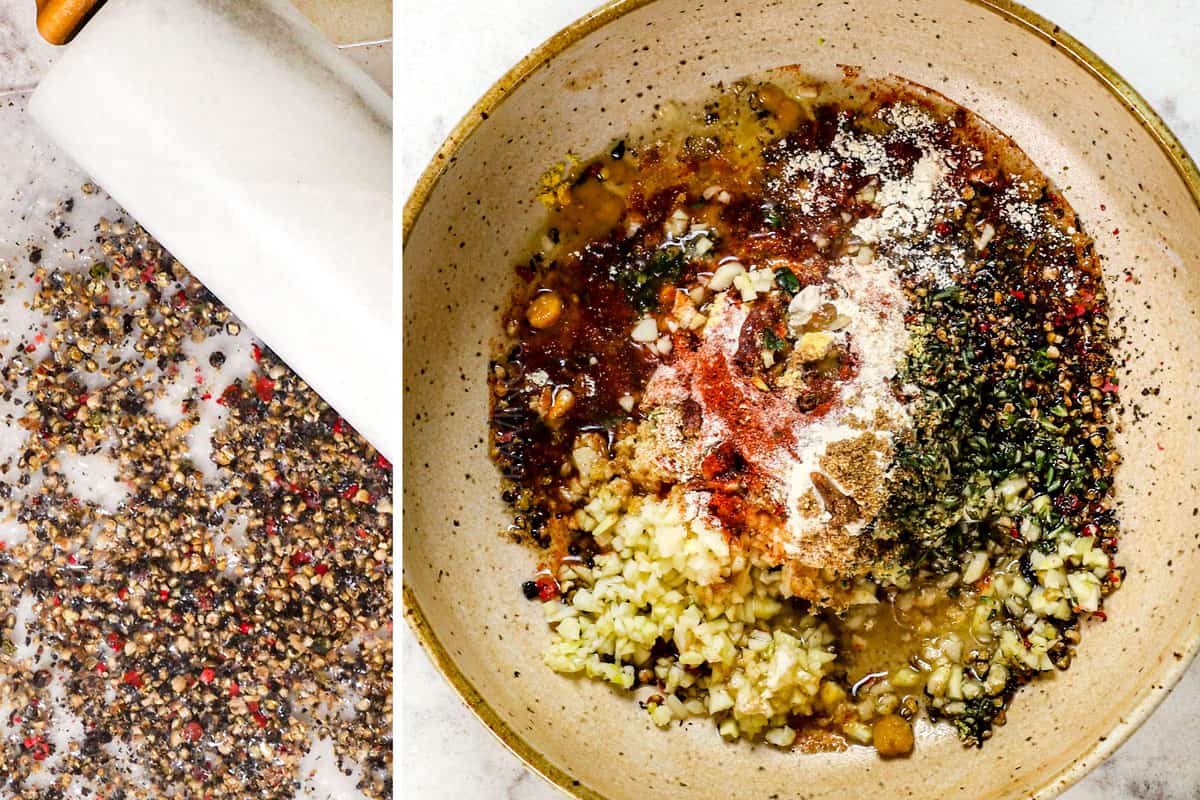
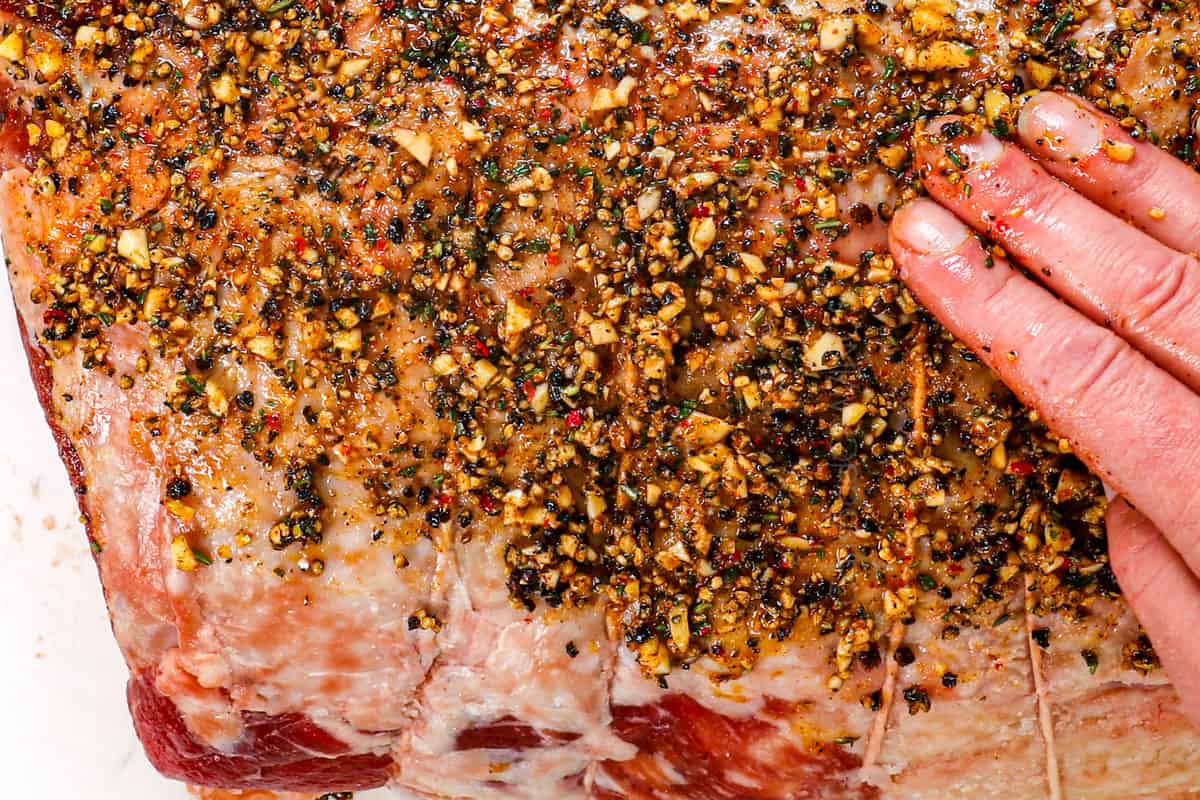
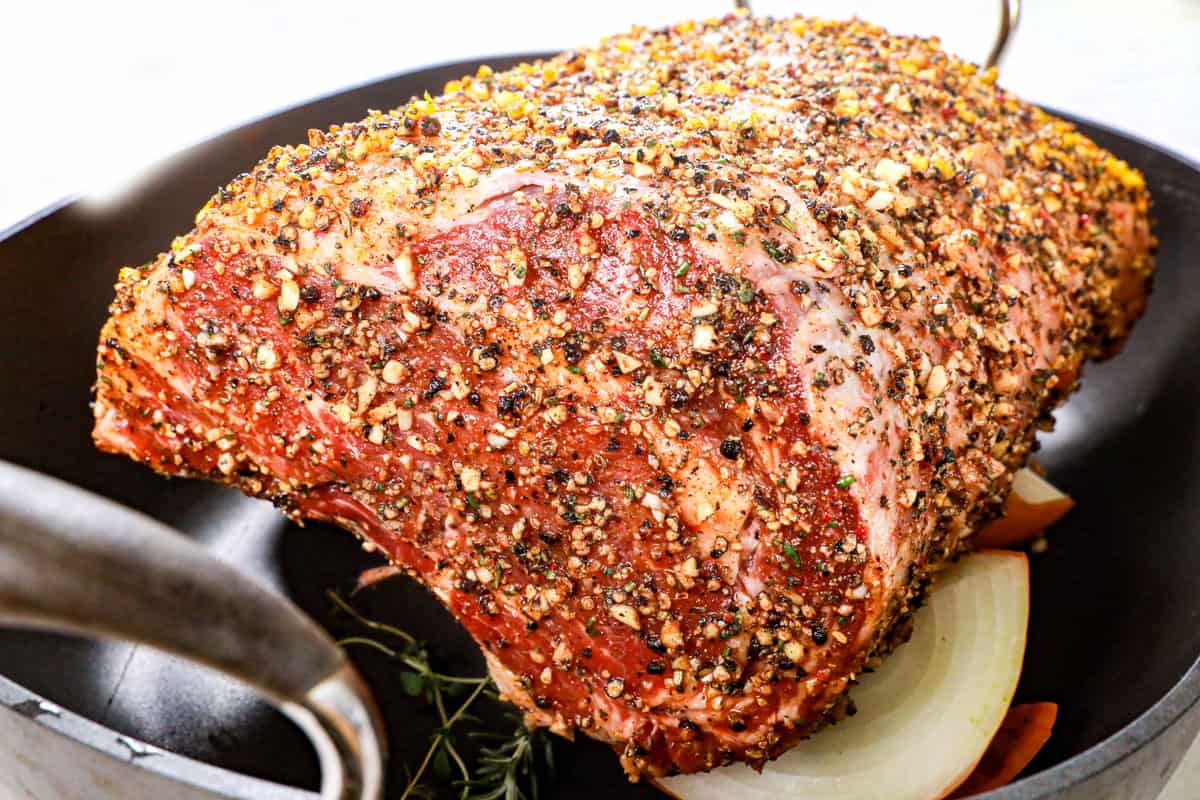
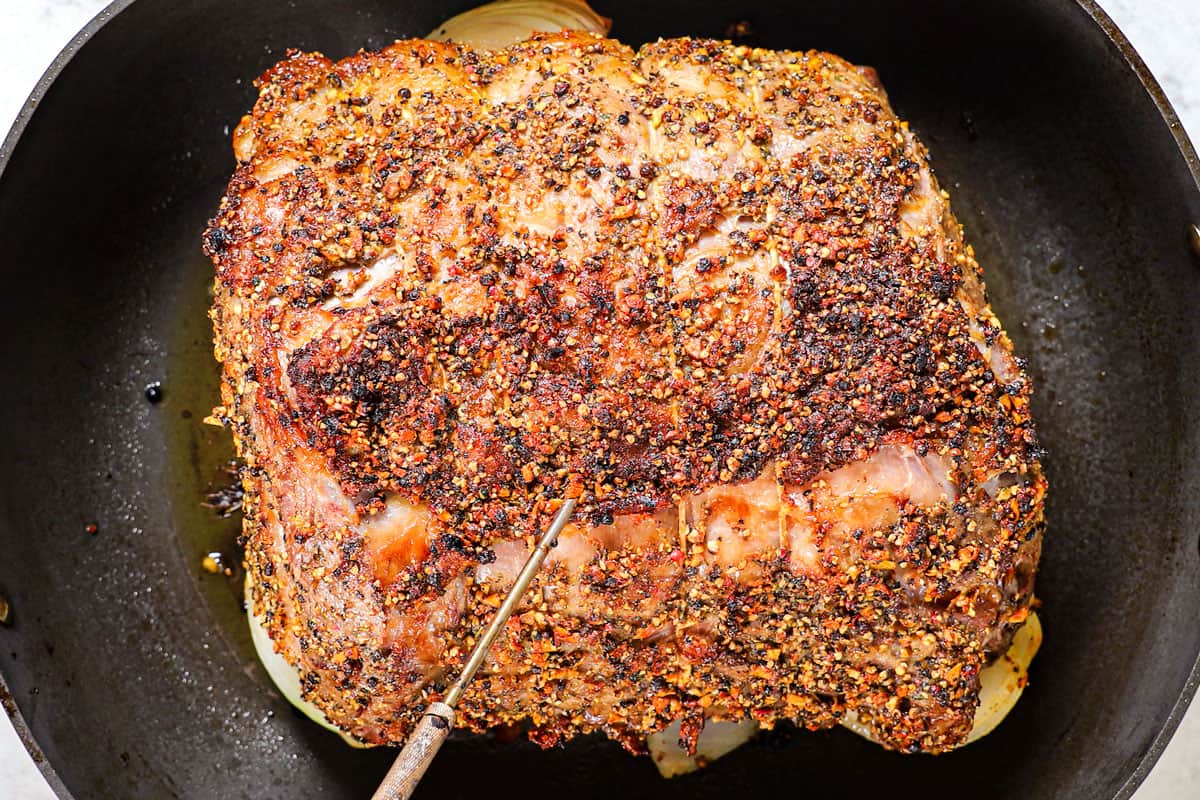
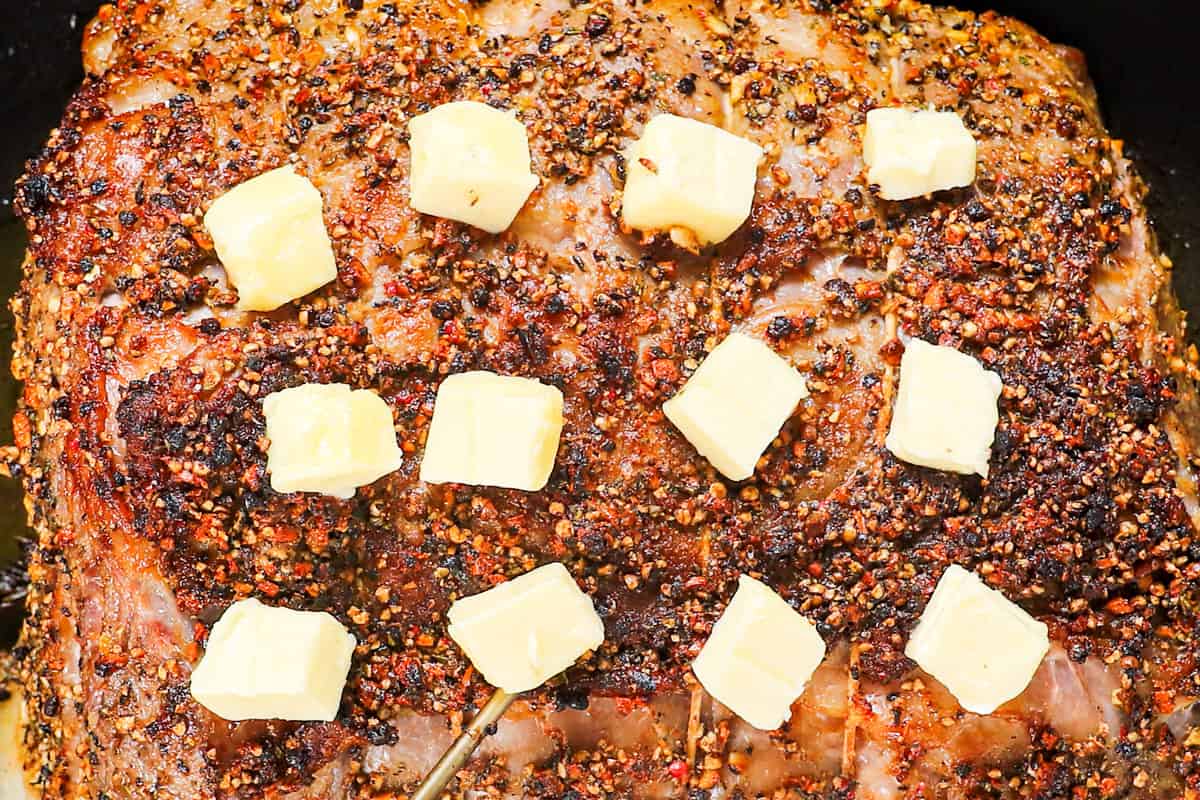
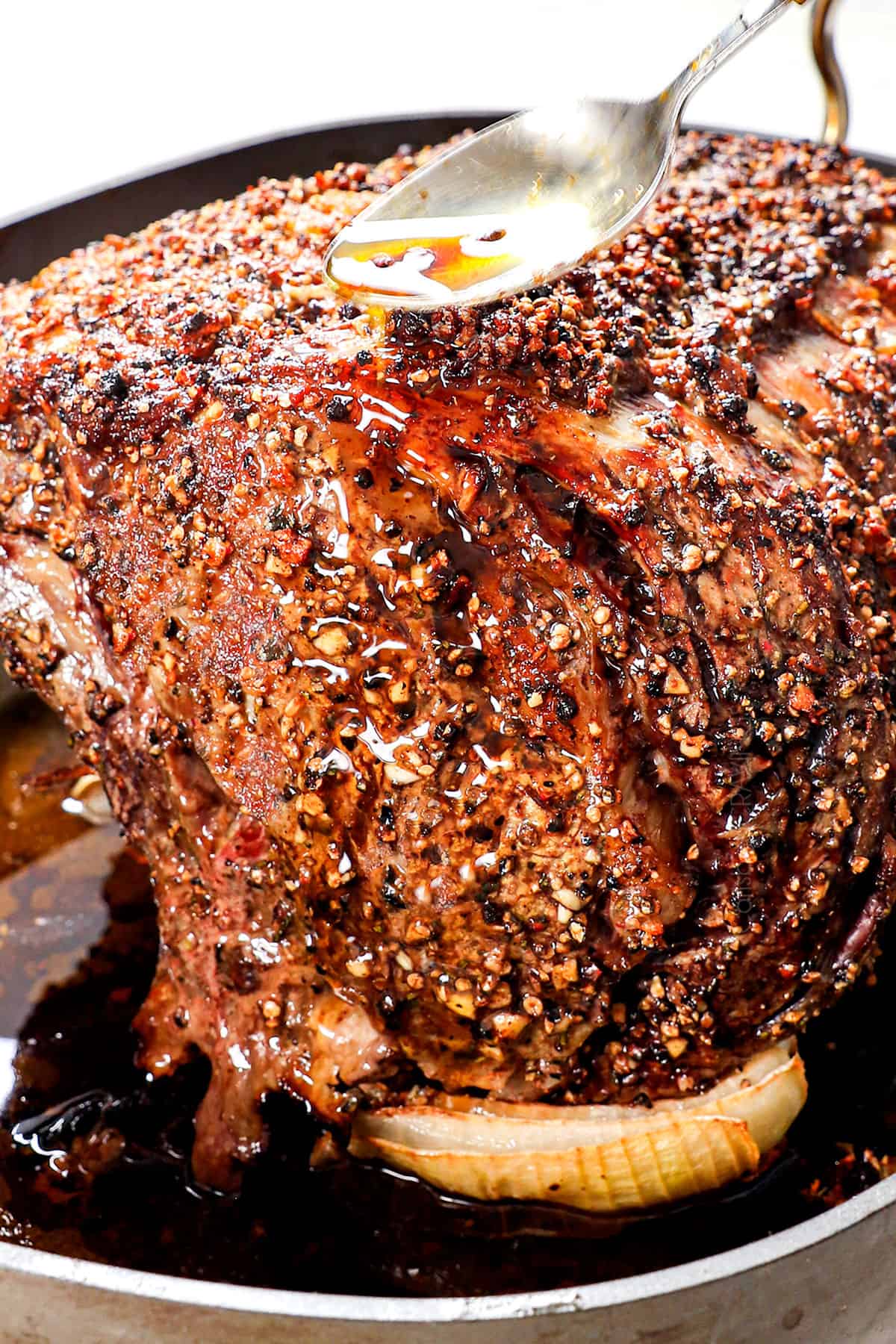

How long to cook Prime Rib?
In general, a bone-in prime rib roast requires approximately 15 minutes per pound for medium-rare. HOWEVER, do not use this approximation for doneness or you are setting yourself up for disappointment. The actual cooking time for prime rib depends on various factors, including the weight of the roast, how long it’s been sitting at room temperature, the desired level of doneness, and actual oven temp (even same-temp ovens vary)- every time you cook, it will be different. You MUST use a digital probe thermometer to know exactly when the prime rib is done.

Temperature chart for the Best Prime Rib
The biggest mistake people make cooking prime rib is not factoring in carryover, meaning, the beef will continue to cook once it’s pulled out of the oven. The trick is to remove the prime rib roast before it reaches your desired temperature. This may sound complicated, but don’t worry, I’ve factored in the carryover in the chart below and exactly what temperature you should remove the roast from the oven:
| Doneness | Pull Temperature | Target Temp After Resting |
|---|---|---|
| Rare | 118°F / 48°C | 124°F/51°C |
| Medium rare (recommended) | 122°F / 50°C | 129°F /54°C |
| Medium (NOT recommended) | 127°F / 53°C | 135°F / 57°C |
| Medium well done (NOT recommended) | 131°F / 55°C | 138°F / 59°C |
| Well done (NOT recommended) | CRIMINAL! | N/A |

Best Prime Rib Roast Recipe tips
Cooking a perfect prime rib is easier than you think! Follow these helpful tips to ensure the best prime rib recipe every time:
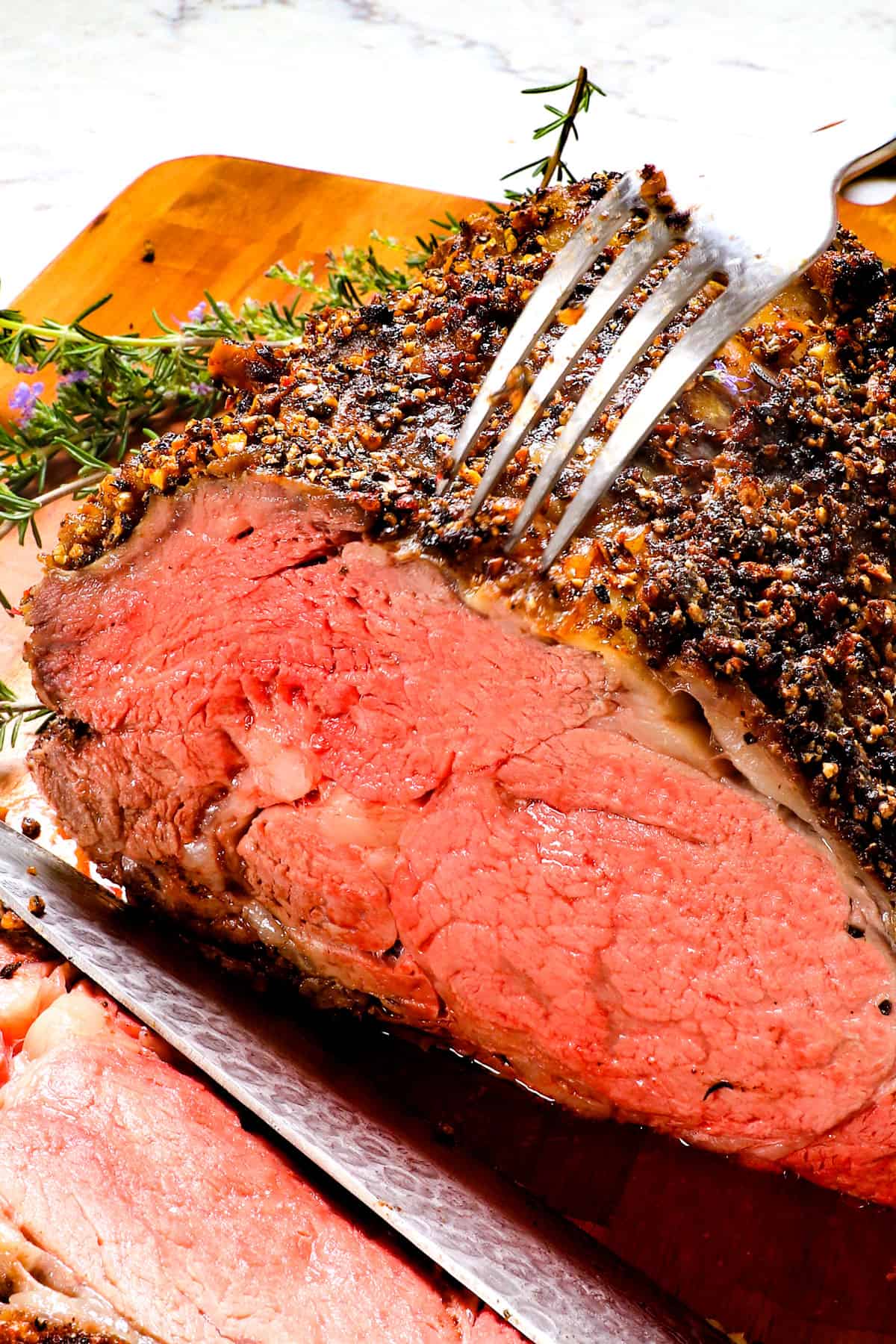

How to serve Prime Rib Roast
Prime rib is often served with a flavorful sauce or au jus to enhance its natural juices and add an extra layer of richness. Here are some common sauces that pair well with standing rib roast:
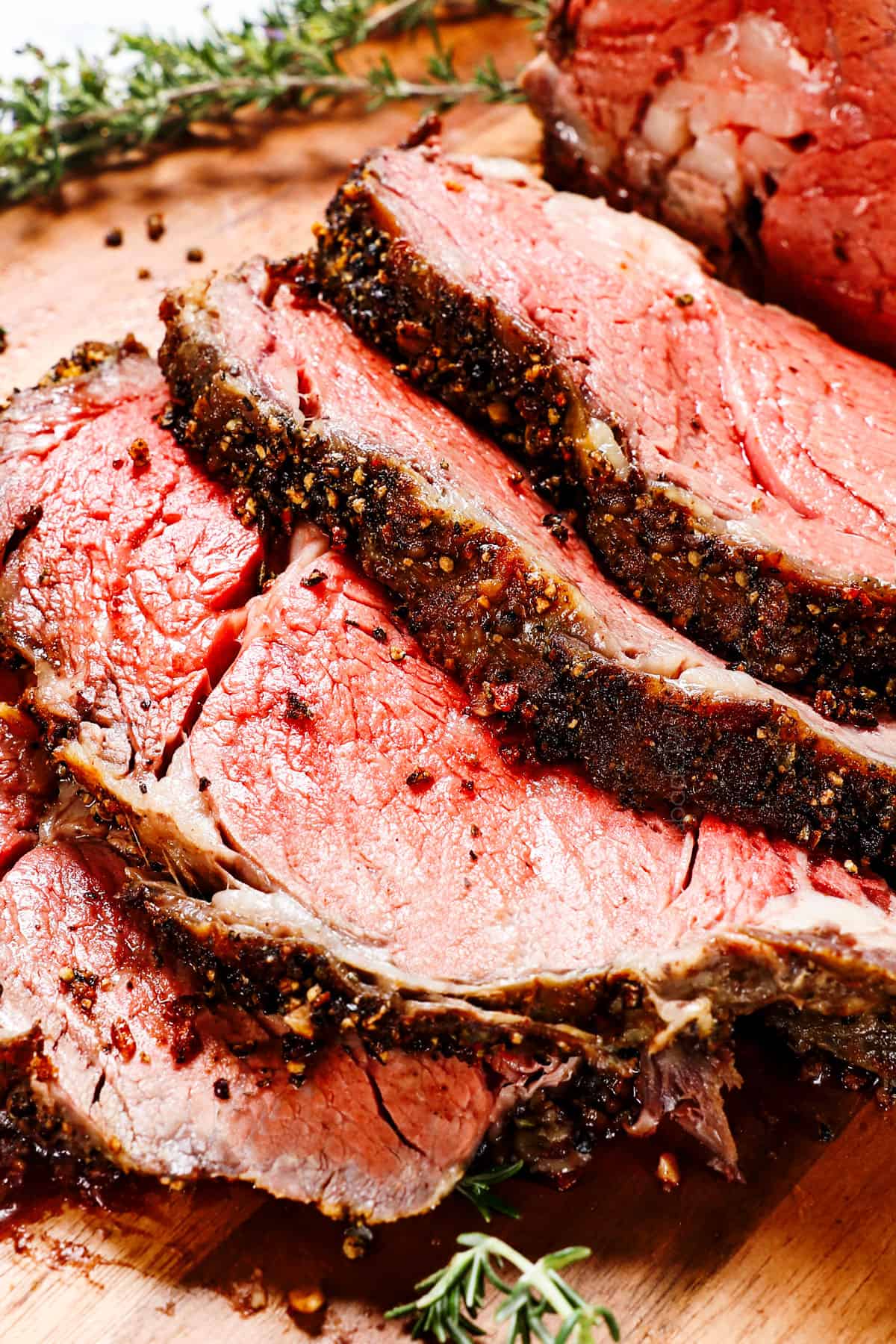

How to cut prime rib
Before carving, allow the cooked standing rib roast to rest for about 20 minutes to redistribute the juices, ensuring juicier meat. Cut the string, unwrap the roast and remove the bones. Place the prime rib flat on a cutting board. Using a sharp carving knife, carve the meat into slices of desired thickness, typically about 1/2-inch.

What to serve with this Recipe for Prime Rib
Nothing is better with this prime rib recipe than Garlic Butter Mashed Potatoes! Of course, we’ll throw in a fantastic salad like Apple Salad and a veggie like Parmesan Asparagus and now you have a meal worthy of your spectacular roast! Feel free to mix and match some of the tasty options below:

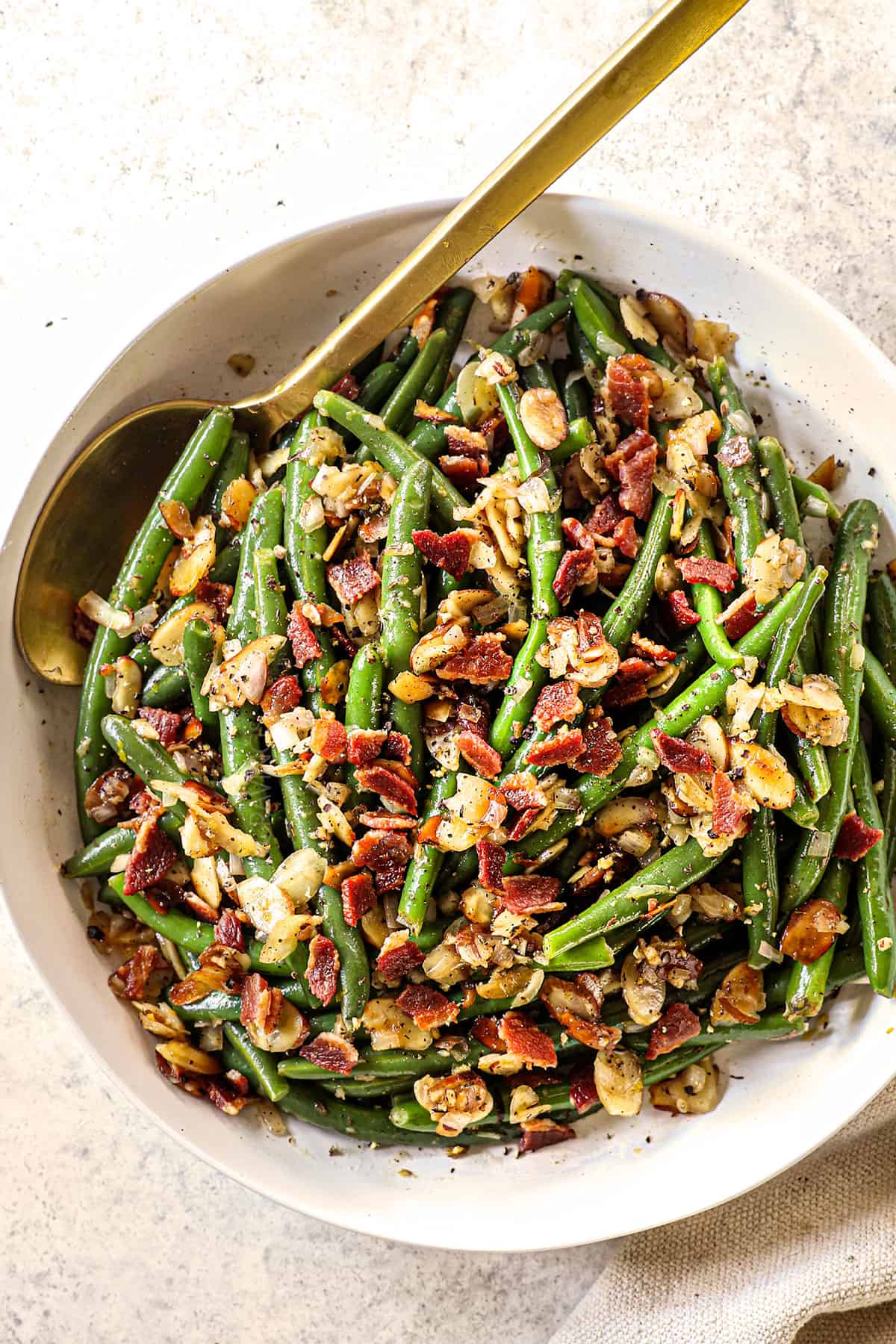
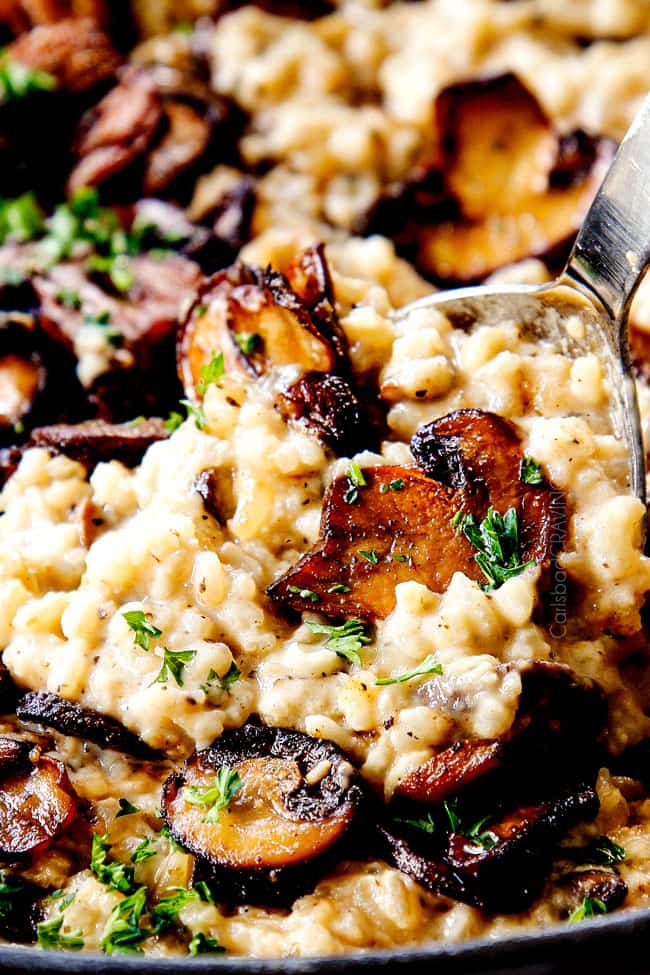




How to store Prime Rib Roast
To store leftover prime rib effectively, allow it to cool to room temperature before wrapping tightly in plastic wrap, aluminum foil, or placing it in an airtight container. Refrigerate for 3 to 4 days for optimal freshness.
HOW TO freeze Prime Rib
For longer storage, freeze the prime rib for up to 3 months. Double wrap the roast tightly in plastic wrap, followed by foil to prevent freezer burn. When ready to use, thaw in the refrigerator a day before, then reheat per any of the below methods.

How to reheat Prime Rib
Reheating prime rib while maintaining its juiciness and tenderness requires a gentle approach to prevent overcooking. Here’s a recommended method:
1. Preheat the Oven: Preheat your oven to 250°F (120°C).
2. Wrap in Foil: Wrap the prime rib in aluminum foil to retain moisture.
3. Reheat Gradually: Place in the oven and reheat the prime rib gradually, allowing it to warm through without overcooking. For precision, use a meat thermometer to check the internal temperature. Aim for a reheating temperature of around 120°F (49°C) for medium-rare.
4. Rest Before Slicing: Allow the reheated prime rib to rest for 10 minutes before slicing. This helps redistribute the juices.
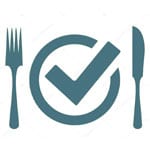
Prime Rib Recipe meal prep
The prime rib can be dried and salted up to 48 hours ahead of time and stored in the refrigerator. The pepper spice rub can be whisked together and refrigerated up to 24 hours ahead of time.
Prime Rib Recipe FAQs
Prime rib, also called “standing rib roast” is considered the “crème de la crème” of beef, highly regarded for its rich marbling, tenderness, and succulent flavor. It is a cut of beef that comes from the primal rib section of the cow, typically from ribs 6 through 12. The outer layer of fat and the rib bones contribute to the meat’s richness and juiciness during cooking. Prime rib roast is an investment cut of beef, often reserved for special occasions or holiday feasts.
Prime rib is a cut of beef that comes from the primal rib section of the cow. It is also known as a standing rib roast because it is often roasted with the ribs left on, which gives it a distinctive and impressive appearance. The specific ribs included in prime rib typically range from ribs 6 through 12. This cut is renowned for its marbling, tenderness, and rich flavor, making it a popular choice for special occasions and holiday feasts.
Prime rib is considered special for several reasons:
1. Marbling and Flavor: It is well-marbled with fat, which contributes to its tenderness, juiciness, rich and succulent flavor.
2 Tenderness: The rib section of the cow, from which prime rib is cut, is known for tenderness.
3. Presentation: Prime rib is often prepared as a standing rib roast which not only adds visual appeal to the roast but also imparts additional flavor during cooking.
4. Special Occasion Dish: Due to its premium qualities, prime rib is frequently reserved for special occasions, celebrations, and holiday feasts. Its association with festive gatherings makes it a symbol of indulgence and luxury.
5. Celebrated Flavor: The natural flavor of prime rib is often celebrated with minimal seasoning to allow the quality of the meat to shine. However, it also provides a canvas for creative rubs, herbs, and spices.
Prime rib and ribeye are both cuts of beef that come from the rib section of the cow, but they have distinct characteristics and are typically prepared and served in different ways.
Prime Rib:
1. Cut: Prime rib is a large roast cut from the primal rib section, often bone-in and including several ribs.
2. Cooking: It is usually roasted whole, with the ribs attached, making it a show-stopping centerpiece for special occasions.
3. Presentation: Slices of prime rib are often served with the bone and a layer of fat, providing richness and flavor.
Ribeye:
1. Cut: Ribeye is a steak cut from the rib section, specifically from the eye of the prime rib roast.
2. Cooking: Ribeye steaks are typically grilled, pan-seared, or cooked using dry heat methods.
3. Presentation: It is a boneless steak with a well-marbled texture, offering a good balance of tenderness and flavor.
Key Differences:
1. Bone: Prime rib often includes the bone, while ribeye is a boneless steak.
2. Cooking Method: Prime rib is commonly roasted, and ribeye is often grilled or seared.
3. Portion Size: Prime rib is a larger cut suitable for serving a group, while ribeye steaks are individual portions.
In summary, prime rib is a roast, and ribeye is a steak cut from the same rib section. Prime rib is often associated with special occasions and festive meals due to its size and presentation, while ribeye steaks offer a more individualized and versatile dining experience.
Leftover prime rib can be repurposed into delicious meals. Use it anyplace you would use steak, ground beef, or even chicken! Here are some ideas for what to do with leftover prime rib:
1. Prime Rib Sandwich: Slice the leftover prime rib thinly and make a hearty sandwich. Add your favorite condiments, cheese, and veggies for a satisfying meal.
2. Prime Rib Hash: Chop the leftover prime rib into small pieces and use it in a breakfast hash. Sauté with potatoes, onions, and bell peppers, and top with a fried egg.
3. Prime Rib Tacos or Quesadillas: Shred the leftover prime rib and use it as a filling for tacos or quesadillas. Add cheese, salsa, and your favorite toppings for a quick and flavorful meal.
4. Beef and Vegetable Soup: Use the prime rib bones to make a rich broth, then add the leftover meat along with vegetables to create a hearty beef and vegetable soup.
5. Prime Rib Fried Rice: Chop the leftover prime rib into small pieces and stir-fry with cooked rice, vegetables, and soy sauce for a tasty prime rib fried rice.
6. Beef Stroganoff: Slice the prime rib into thin strips and use it in a classic beef stroganoff. Serve over egg noodles or rice for a comforting dish.
7. Prime Rib Salad: Slice the leftover prime rib thinly and serve it over a bed of mixed greens with your favorite salad toppings. Drizzle with a vinaigrette for a lighter option.
8. Beef and Cheese Stuffed Baked Potatoes: Scoop out baked potatoes, mix the flesh with chopped prime rib, cheese, and other desired toppings, then stuff the mixture back into the potato skins and bake until golden.
9. Prime Rib Pizza: Use leftover prime rib as a pizza topping. Combine with cheese, onions, mushrooms, or other favorite pizza ingredients for a unique and flavorful pizza.
10. Prime Rib Frittata: Whisk eggs, add chopped prime rib, vegetables, and cheese, then bake for a delicious prime rib frittata, perfect for breakfast or brunch.
First, sear the prime rib in the oven at 500 degrees F to create a deeply flavorful caramelized crust that seals in the juices. Next, reduce the temperature to 250°F and cook low and slow. This lower oven temperature allows for more even cooking (without a thick, overcooked outer ring), allowing the fat to melt and baste the meat as it cooks, achieving a beautiful
blushing pink all the way through.
It’s best to cook prime rib at 250°F for more even cooking and increased juiciness. This method allows for a gradual breakdown of connective tissues, resulting in a more tender and flavorful outcome. The extended cooking time at a lower temperature reduces the risk of overcooking the outer layers, and provides a larger window to achieve the desired internal temperature.
The amount of prime rib needed per person can vary based on factors such as the size of the roast, the appetites of your guests, and the additional sides being served. As a general guideline, you can estimate about ¾ to 1 pound of bone-in prime rib per person. This may sound like a lot, but some of that weight is bone and the prime rib roast will weigh less after cooking.
No, you should not cover prime rib when cooking. Leaving the roast uncovered during cooking creates the prized delectably crispy and flavorful crust on the exterior and succulent, juicy interior. Additionally, the exposure to open air promotes even browning, rendering of surface fat, and optimal heat circulation around the entire roast.
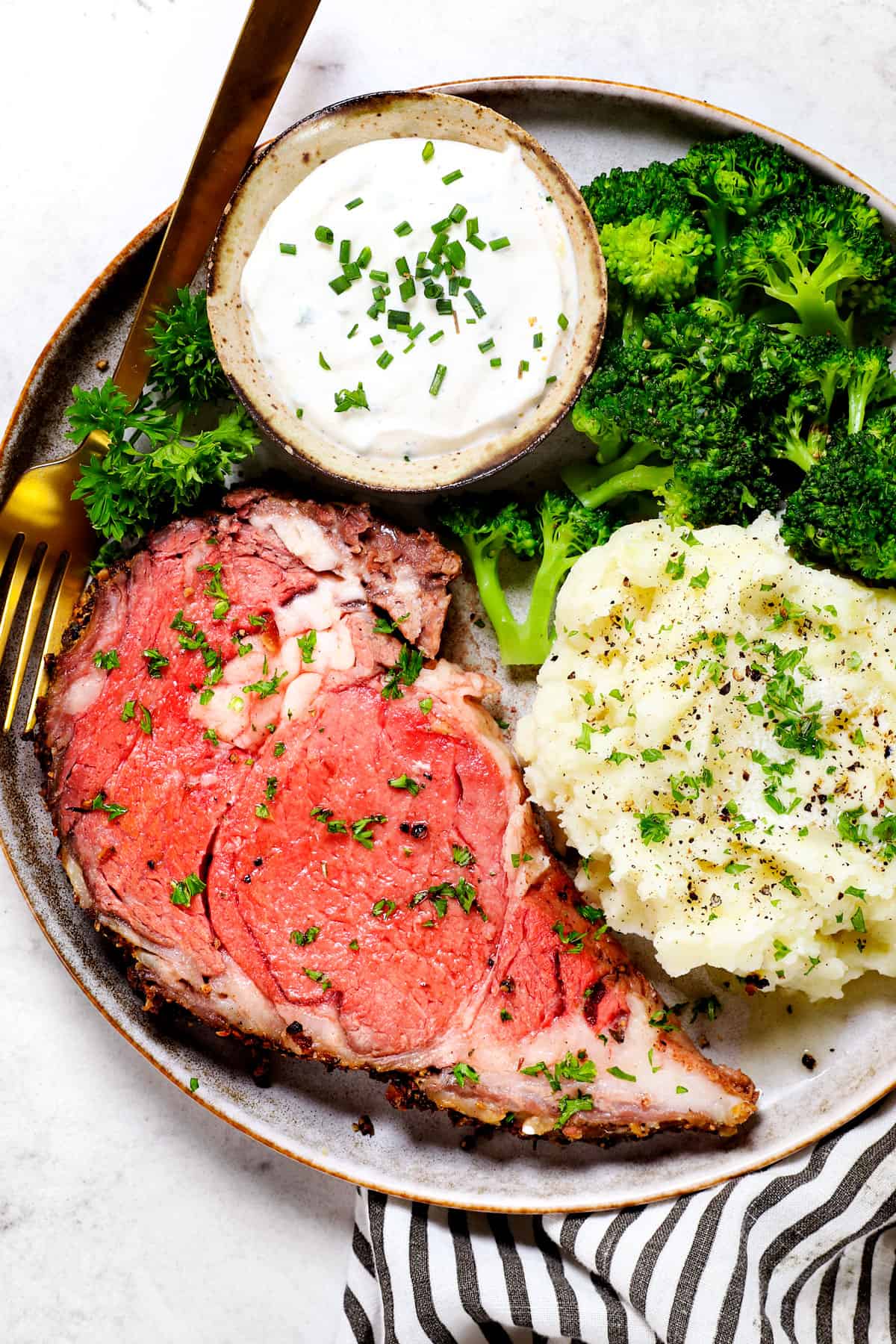
WANT TO TRY THIS Prime Rib RECIPE?
PIN IT to your recipe BOARD TO SAVE FOR LATER!
FIND ME ON PINTEREST FOR MORE GREAT RECIPES! I AM ALWAYS PINNING :)!
©Carlsbad Cravings by CarlsbadCravings.com
Tools Used in This Recipe
See Favorite Tools
Best Recipe for Prime Rib
Save This Recipe To Your Recipe Box
You can now create an account on our site and save your favorite recipes all in one place!
Ingredients
Prime Rib
- 1 10 pound roast-ready prime rib roast (ribs cut off and tied to roast)***
- 2 tablespoons Morton's kosher salt (3 ½ Tablespoons for Diamond brand)
- 4 tablespoons unsalted butter, chopped into 9 pieces
Garlic Herb Pepper Spice Rub
- 1/4 cup multicolor whole peppercorns (peppercorn blend)
- 1/4 cup olive oil
- 1 1/2 teaspoons minced rosemary leaves (measure after mincing)
- 1 teaspoon minced thyme leaves (measure after mincing)
- 1/4 cup finely chopped garlic (DO NOT use a garlic press)
- 1 tsp EACH onion powder, paprika
- 1/2 tsp EACH ground coriander, ground mustard
ROASTING BED
- 1 yellow onion unpeeled, quartered
- 1 head garlic, unpeeled, sliced through the equator
- 5 sprigs fresh thyme
- 3 sprigs fresh rosemary
For Serving (Optional)
- 1 recipe Horseradish Sauce <<<Click for recipe
Instructions
- Dry Brine Prime Rib: Pat the meat dry with paper towels. Sprinkle evenly with kosher salt on all sides. Pat the salt into the meat. Tent with foil and refrigerate for as long as you have time for, up to 48 hours. Even a few hours is better than nothing! If you don’t have time, salt the meat, then let it dry brine as it comes to room temperature (next step).
- Bring to Room Temperature: For a 10-pound prime rib roast, let it sit at room temperature for 4-5 hours. For a smaller prime rib, let it sit at room temperature for 3 hours. Meanwhile, preheat the oven to 500˚F with rack in the lower third of the oven, so the prime rib will be in the center.
- Create Roasting Bed: Place the quartered onion, halved garlic, rosemary and thyme in the bottom of a roasting pan (preferably nonstick for easy cleanup (like this one).
- Make Garlic Herb Pepper Spice Rub: Add the peppercorns to a plastic bag, then use a rolling pin to crush them completely. Transfer to a medium bowl and add the rest of the Spice Rub ingredients. Stir to evenly combine.
- Season Prime Rib: When ready to roast, lightly pat the room temperature prime rib with paper towels. Rub all over with the Spice Rub.
- Add Thermometer: Transfer the prime rib to the roasting bed in the roasting pan, bone-side-down, fat side up. Insert a digital probe meat thermometer (A MUST) into the center thickest portion of the meat. This thermometer is my favorite (seen in the video) and only $25 on Amazon.
- Oven Sear: Bake, uncovered, at 500˚F for 20 minutes.
- Add Butter: After searing, remove the prime rib from the oven. Reduce oven temperature to 250˚ F. Dot the roast with cubed butter down the center.
- Slow Roast: Return prime rib to the oven to roast, uncovered, at 250˚ F, until the thermometer reaches 122° F (this will be medium-rare and will rise to 129°F after carryover). See Temperature Chart in Notes. This should take approximately 15 minutes per pound, but DO NOT rely on this approximation – you MUST USE a digital probe thermometer or you will RUIN your roast!
- Baste and Rest: Remove the medium-rare prime rib from the oven. Thoroughly baste the roast with the juices from the bottom of the pan. Transfer prime rib to a cutting board. Cover loosely with foil and rest for 20 minutes, or until the internal temperature rises to desired doneness (129°F for medium rare).
- Carve: Cut the string, unwrap the roast and remove the bones. Place the prime rib flat on a cutting board. Using a sharp carving knife, carve the meat into slices of desired thickness, typically about 1/2-inch thick.
- Serve: I recommend serving with this 5 Minute Horseradish Sauce <<<Click for recipe, or see post for other options such as au jus and red wine sauce.
Video
Notes
- Scale Up or Down: This recipe can be scaled down to any size roast by using the sliding scale that pops up when you hover over the servings in the recipe card. (Note, this will not change the amount of Diamond Kosher Salt in parentheticals, so calculate or stick with Morton’s brand).
- ***Purchasing prime rib:
- Digital probe thermometer MUST: You need a probe meat thermometer that stays in the meat while it cooks, otherwise, you are opening and closing the door to check the temperature which disrupts even cooking. Also, it’s difficult cook the prime rib perfectly. I recommend this digital probe thermometer as seen in the photos and video. Only $25 on Amazon.
- Multi-color peppercorns: Each type of peppercorn contributes a unique flavor profile and aroma to the blend creating a more complex and nuanced flavor than all black. You should be able to find with the spices at your grocery store, or on AMAZON HERE.
Temperature Chart
| Doneness | Pull Temperature | Target Temp After Resting |
|---|---|---|
| Rare | 118°F / 48°C | 124°F/51°C |
| Medium rare (recommended) | 122°F / 50°C | 129°F /54°C |
| Medium (NOT recommended) | 127°F / 53°C | 135°F / 57°C |
| Medium well done (NOT recommended) | 131°F / 55°C | 138°F / 59°C |
| Well done (NOT recommended) | CRIMINAL! | N/A |
- Prep ahead: The prime rib can be dried and salted up to 48 hours ahead of time and stored in the refrigerator. The pepper spice rub can be whisked together and refrigerated up to 24 hours ahead of time.
- Storage: Cool to room temperature before wrapping tightly in plastic wrap, aluminum foil, or placing in an airtight container. Refrigerate for 3 to 4 days. For longer storage, freeze the prime rib for up to 3 months. Double wrap the roast tightly in plastic wrap, followed by foil to prevent freezer burn. When ready to use, thaw in the refrigerator a day before, then reheat per any of the below methods.

Did You Make This Recipe?
Tag @CarlsbadCravings and Use #CarlsbadCravngs
Leave a Review, I Always Love Hearing From You!

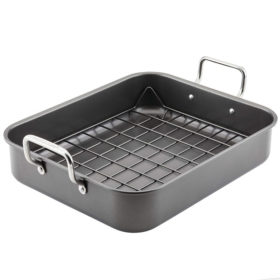
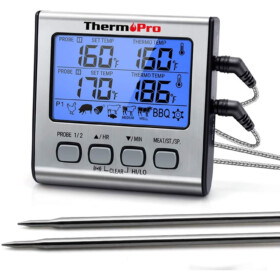

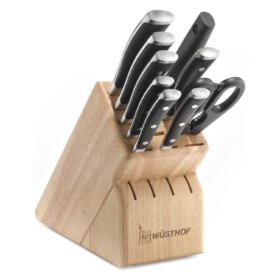

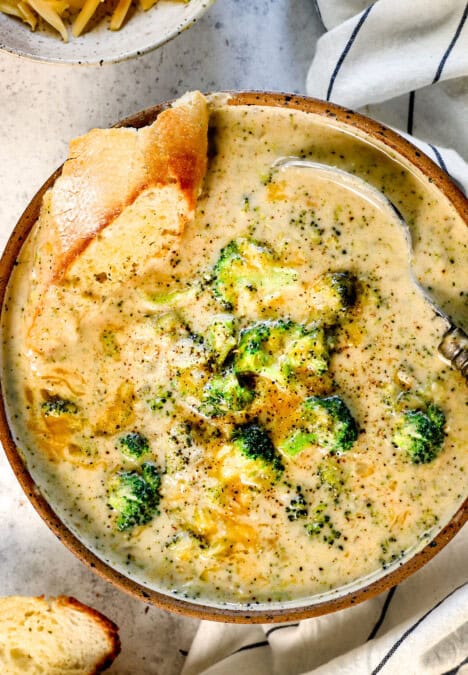

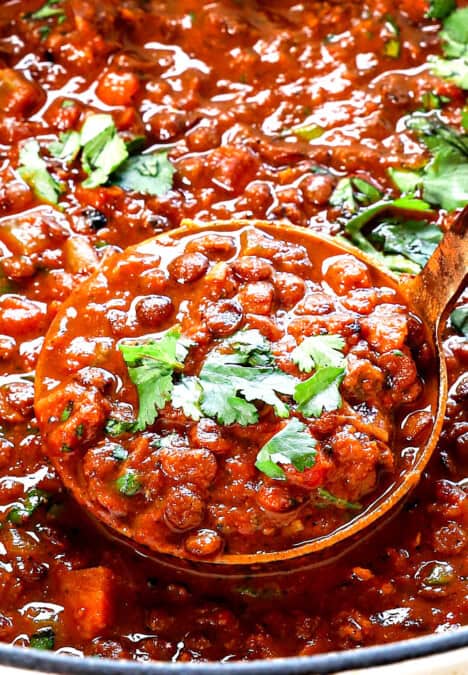
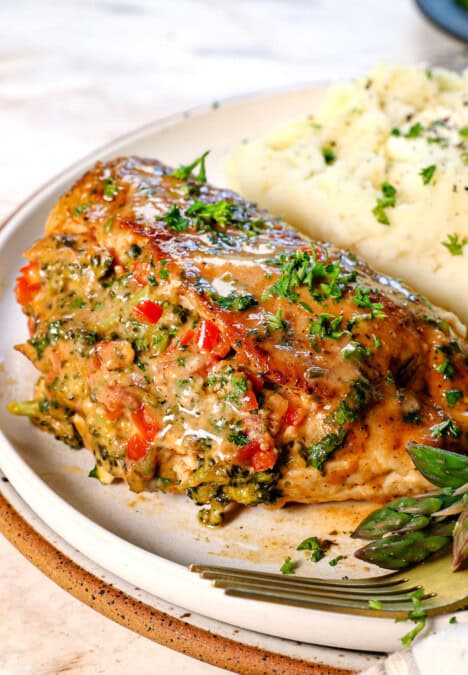
























Jason says
Made this recipe for dinner tonight. My roommate and I both agree it was the best prime rib we’ve ever had. It was only a 4lb roast so I halved the other ingredients and it came out wonderful. The garlic herb pepper spice rub was a perfect blend of flavors. I only have prime rib maybe once every few years, but this recipe is the one to use when that time comes around again. Thanks for the wonderful recipe!
Jen says
I’m so thrilled that this is a keeper!
Joy says
I used your recipe to make my first prime rib for our Christmas dinner and it came out beautifully! Realizing now that I totally forgot the step of basting it after pulling it from the oven, but it was still perfectly juicy and sooo tasty. Everyone loved it, along with your recipes for the horseradish sauce and potatoes au gratin.
I was very skeptical about how much the meat’s temperature would continue to rise after pulling it from the oven, but sure enough after pulling it at 123° it rose all the way to 135° after sitting for 20 mins! Next time I might pull it a few degrees earlier even, but still I was very happy with the results. I appreciated all the detailed tips, as they were exactly what I needed not wanting to risk messing up such a pricy cut of meat. Thank you!!
Jen says
Thank you so much for giving this recipe a try! I’m so glad that it was a hit!
Jaclyn Yeaton says
First, let me start off with saying that I never leave comments but this was so good I had to!! Your recipes never disappoint and this was no exception!! I had never made prime rib and was so intimidated! Your recipe was very easy to follow and turned out absolutely perfect!!! The best prime rib I’ve ever had!!
Jen says
Thank you for taking the time to leave such a wonderful review! I’m so glad that you loved it!
Alli Forsyth says
Just want to say thank you for such a complete recipe. You covered everything. Even what to ask for at the butcher. It turned out so amazing! I’ve been scared to try a prime rib because of the cost but you made it feel easy! Thank you for taking the time to write such great recipes with so many details!
Jen says
I am thrilled that you enjoyed the tips and that it turned out so well! Thank you for such a kind review!
Vimy says
This was delicious. I followed the recipe and it was easy to make!
Jen says
That’s so wonderful to hear! Thank you Vimy!
Sara G says
Followed recipe to a T and it was OUTSTANDING!! Made the horseradish sauce as well and will add a little more kick, for our taste, next time but still very good. Your recipes are always incredibly delicious!! Thank you for another one
Jen says
Wow Sara! Thank you so much for taking the time to leave your review! I’m thrilled that you loved this and other recipes of mine! I hope you have a wonderful New Year!